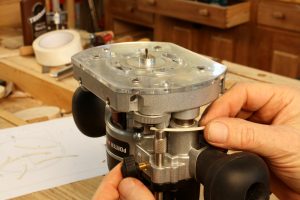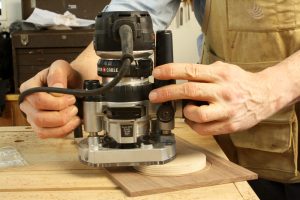We may receive a commission when you use our affiliate links. However, this does not impact our recommendations.
 A plunge router is a versatile tool, but setting an exact depth can be perplexing. There are a bunch of knobs and levers that control how far down the bit will go, but if you’re trying to make a precise adjustment you rapidly run out of hands and patience as you fight the springs and line up a ruler. There is an easy way to do it; here is how I set the depth for the mother-of-pearl inlay on the face of the Voysey mantel clock I made for the August 2013 issue of Popular Woodworking Magazine. If you click on the photo, a larger version will appear that will give you a better look at what I’m doing.
A plunge router is a versatile tool, but setting an exact depth can be perplexing. There are a bunch of knobs and levers that control how far down the bit will go, but if you’re trying to make a precise adjustment you rapidly run out of hands and patience as you fight the springs and line up a ruler. There is an easy way to do it; here is how I set the depth for the mother-of-pearl inlay on the face of the Voysey mantel clock I made for the August 2013 issue of Popular Woodworking Magazine. If you click on the photo, a larger version will appear that will give you a better look at what I’m doing.
First I placed the template (a plywood circle) in position on the face. Because the template is so small, there wasn’t any room for clamps. I put some double-sided tape on the bottom of the template, and also drove a screw through the template and walnut face and into my bench.  With everything secure, I set the router on the template and lowered the bit until it bottomed out on the face and locked the depth-control lever. Then I flipped the router upside down. I released the depth-stop rod, stuck a piece of the inlay between the rod and the stop on the router base, pushed the rod up and tightened it.
With everything secure, I set the router on the template and lowered the bit until it bottomed out on the face and locked the depth-control lever. Then I flipped the router upside down. I released the depth-stop rod, stuck a piece of the inlay between the rod and the stop on the router base, pushed the rod up and tightened it.
That changed my setting from where it was (the surface of the face) to where I wanted it – below the face by the thickness of the inlay. When I went to make the cut, all I had to do was release the lever so the router was above the work, turn it on and drop it down to the position of the stop and lock the lever again. No measurements, no numbers and right on the money.
We filmed a start-to-finish video of me building the clock. It’s a great project and you can get the video from our store.
Here are some supplies and tools we find essential in our everyday work around the shop. We may receive a commission from sales referred by our links; however, we have carefully selected these products for their usefulness and quality.








That’s a neat trick. Like many neat tricks, it seems so obvious, once someone points it out…
I’m thinking you could also use gauge blocks, or even a taper gauge to set the depth for fixed increments. Beats using the gauge on the router!